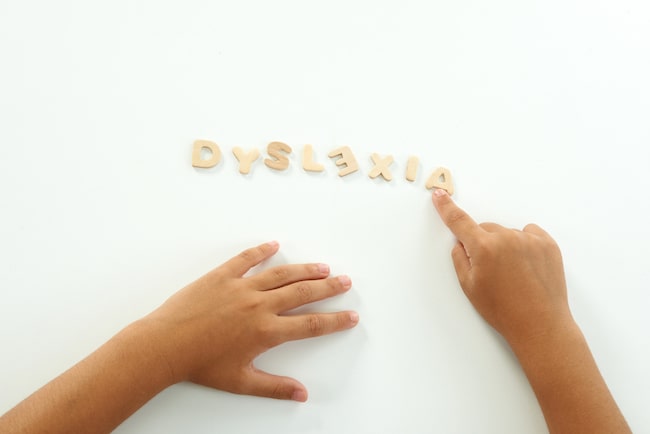Spelling strategies for dyslexia

English is a particularly difficult language when it comes to spelling. There are so many exceptions to the rules! I before E except after C is a case in point. We received the package (there’s the spelling rule in practice) but what we received was a weird and feisty little monkey (and there are two exceptions).
More problematic is perhaps the fact that in English the same letter(s) can be used to represent different sounds and sometimes the same sound can be spelled with different letters! Additionally, there are inherited ways of spelling that no longer go with today's pronunciation. All in all, it can quickly get confusing. That's why teaching English spelling to children and adults is no easy task, but give a sympathetic thought then to the student who struggles with dyslexia.
What is dyslexia?
Dyslexia is a learning difficulty - also called a learning difference, and in some countries a learning disability – which can affect the skills involved in reading and spelling. It is a difference in the way in which the brain processes language, and it can affect visual and auditory processing as well.
Dyslexia is separate from intelligence and is found across a range of intellectual capabilities. You can be of normal intelligence and mildly or severely dyslexic, or you can be absolutely brilliant and mildly or severely dyslexic. It is thought that up to 10% of the population is affected personally by dyslexia; some believe it’s even more than this.

How dyslexia affects spelling
Fed – wed – red these English words have three distinct sounds. To be able to differentiate between the sounds is to have phonemic awareness. This, and the ability to make connections between sounds and letters and letter combinations is how we develop fluent reading and spelling skills. Dyslexia affects spelling when students are not able to hear the small units of sound that represent meaning. They therefore have difficulty in encoding and decoding words, skills which are necessary in order to manipulate written language.
Remember that 10% or more statistic? It applies right across the world. However, you won’t necessarily see everyone who has dyslexia experiencing the same difficulties with spelling. That's because phonemes in some languages are more orthographically transparent. For example, Spanish and Italian words are more consistent in the way they map letters to sounds. They are therefore easier than English words to spell. Chinese is another interesting example. Its written language is constructed of symbols and pictograms which may be more easily remembered.
Dyslexia in a school environment
School spelling tests can be a nightmare for dyslexic students. Because dyslexia affects working memory, a student might study for a spelling test and do well, and then tomorrow, not be able to spell what they spelled correctly on the test.
This can get students in trouble, especially when the dyslexia has not been identified. It might be incorrectly assumed a student is not trying or doesn't care about their performance on some assignments. Consider too that many people with dyslexia are highly articulate and bright, which can seem inconsistent with the literacy and spelling struggles they experience.
Students with dyslexia can have good days and bad days.
Some students with dyslexia will choose the simplest words available to spell, which means their writing does not reflect the richness of their vocabulary.
When children without specific learning difficulties learn to read, they can frequently learn to recognize and spell sight words easily and without trying. These are the linking words like in - and – but - the – which make up much of the language in newspapers, magazines and school tests. But for the child with dyslexia, the sight words may have to be taught.
TIP: A strategy here is to develop your own list of specific words you have difficulty with, and keep it in your pocket so you can refer to it whenever you need to.
Dyslexia can be resistant to traditional teaching methods and so the term “dyslexia-friendly teaching” has emerged to identify practices that work. Everyone, dyslexic or not, can learn from dyslexia-friendly approaches to reading and spelling.

Try these tips
- Early recognition and appropriate dyslexia-friendly interventions are key. Dyslexia is usually something you are born with and often runs in families. What helps greatly is to recognize the dyslexia as early as possible and find and apply the strategies that work best for an individual's particular circumstances.
- Choose a teaching strategy based on phonetics and linguistics. One particularly well-respected approach to learning to spell is to be found in Alpha to Omega: The A-Z of Teaching Reading, Writing and Spelling by Beve Hornsby and colleagues, published by Heinemann Educational Publishers. Dr. Hornsby firmly believed that a dyslexic individual following her program should not be asked to spell anything which hasn’t been specifically taught. The word lists from Touch-type Read and Spell are based on the word lists found in this book.
- Learn to touch-type the TTRS way. Touch-type Read and Spell students say that taking the course gives them a new strategy for remembering spelling. They visualize the keyboard, and “watch” where their fingers fall. Some students with dyslexia may need to overlearn to get spelling from their short-term into their long-term memory.
- Don’t worry about spelling rules. So number four is a bit tongue in cheek as teachers might not let you get away with it, but don’t worry too much about the rules of spelling. Find a way that works - for example touch-typing, and learn the words until they become automatic. Let your fingers develop a memory of their own. Master this skill as early in life as you can, and then rely on automatic spell checks to help you out.
- Learn English words that sound the same but are spelled differently. There is more than one way of spelling many words: She can write, right? This is a base for the bass. Long may she reign in the rain. To learn these words you might harness the finger memory that comes from automaticity in touch-typing and visualize a keyboard, then just watch where the fingers fall.
- Use mnemonic devices to help you with tricky words. You might work out a creative sentence or phrase where the first letter of each word spells out something you have difficulty remembering. An example is a way to spell BECAUSE – a word which commonly causes difficulty. So here we go with Big Elephants Can’t Always Use Small Exits. If you design mnemonic devices for yourself, you will have an easier time remembering them. Be creative; be silly. In fact, the sillier the better to make it easier to remember!
Learn more about helping children with dyslexia in the classroom in this article.
Do you have any spelling strategies that work well for you? Send us an email and join the discussion!
For learners who struggle with dyslexia
TTRS is a program designed to get children and adults with dyslexia touch-typing, with additional support for reading and spelling.
Meredith Cicerchia
TTRS has a solution for you
An award-winning, multi-sensory course that teaches typing, reading and spelling

How does TTRS work?
Developed in line with language and education research
Teaches typing using a multi-sensory approach
The course is modular in design and easy to navigate
Includes school and personal interest subjects
Positive feedback and positive reinforcement
Reporting features help you monitor usage and progress















